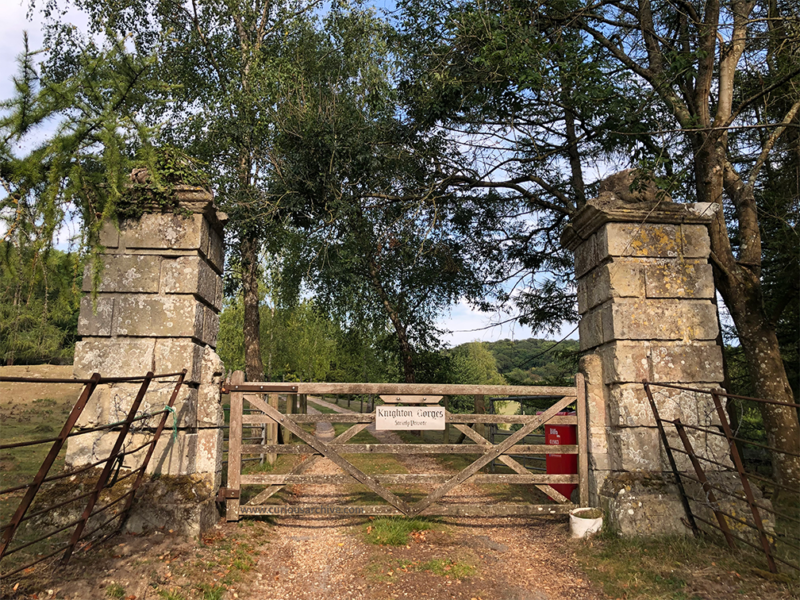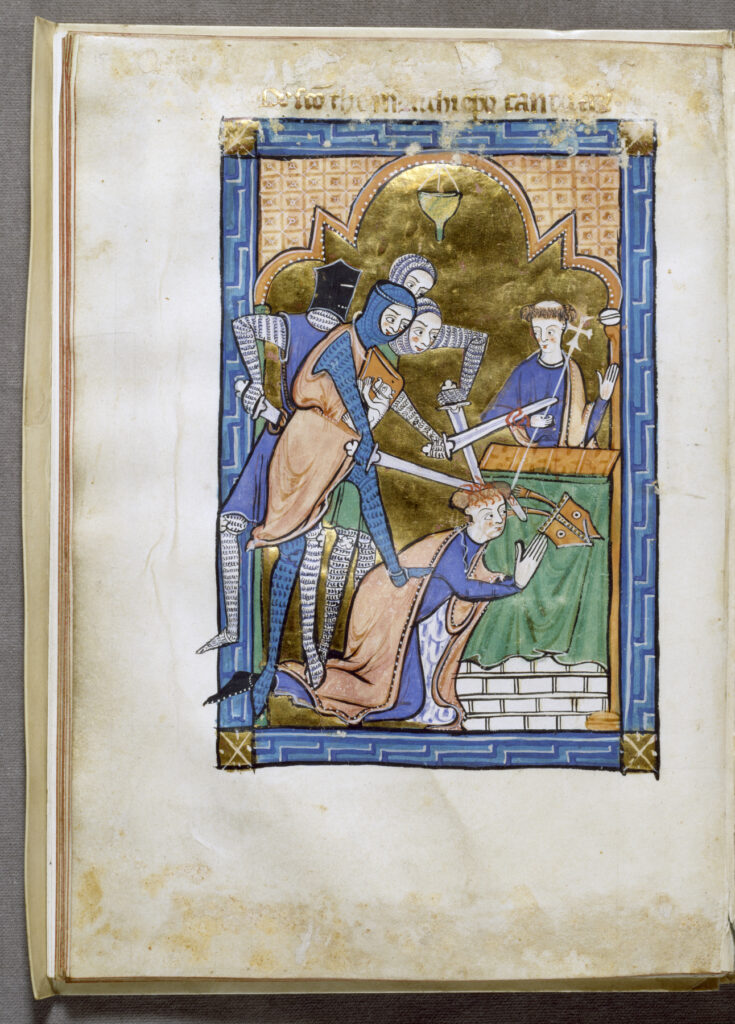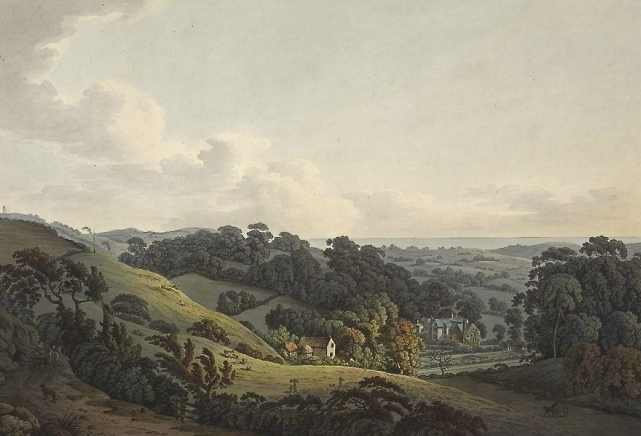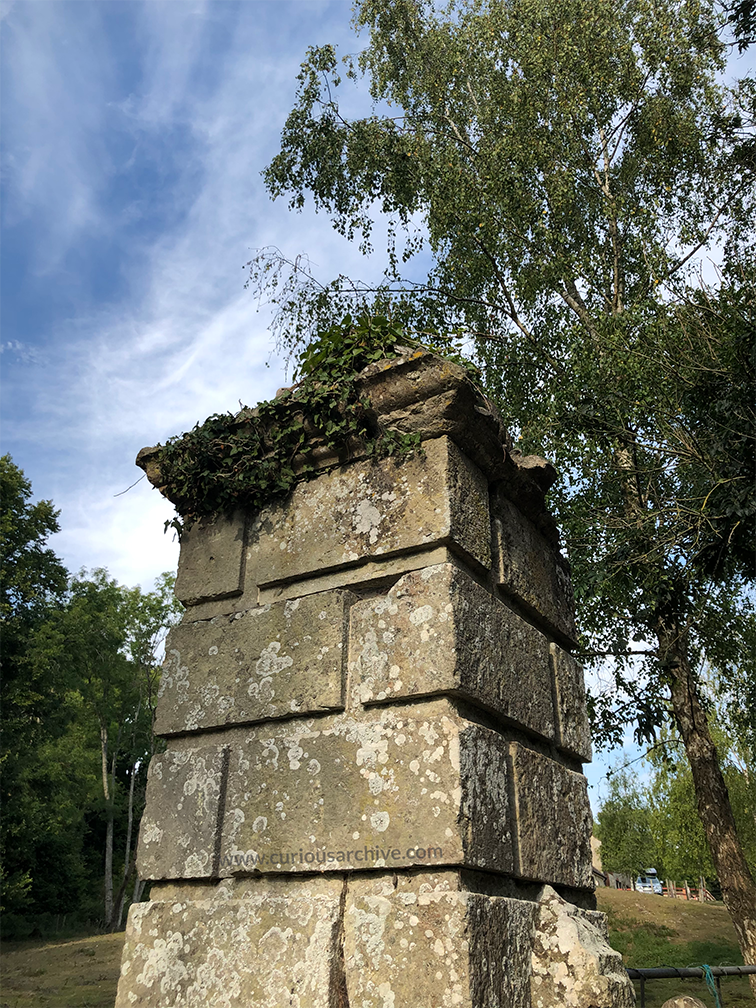The Tragic History of Knighton Gorges, the Isle of Wight’s most Haunted Location
The manor house of Knighton Gorges, historically considered to be one of the finest homes on the Isle of Wight, was built sometime during the twelfth-century. Before it’s destruction in the nineteenth-century, antiquarian Sir Henry Englefield visited the home and described it as “by far the most considerable and beautiful of the ancient mansions of the Island.” During the nearly 700 years Knighton Gorges proudly stood, the house saw a lengthy list of homeowners come and go, all typically of a higher societal standing, until it burned down in 1821. And with so many families filtering in and out of its doors, Knighton witnessed a number of tragedies over the centuries that left locals questioning if the house was cursed.
Today, the Isle of Wight is a known paranormal hotspot, and Knighton Gorges is widely believed to be the most haunted location on the entire island. But all that remains of this once grand home are the large, decaying stone pillars of the front gateway. So how can a house that no longer exists have such a paranormal reputation?

© Curious Archive, 2021.
A Brief History of the Cursed Island Home
As with any local legend, Knighton Gorges’ colourful history is based on stories that have been passed around for (in some cases) over a hundred years. So while the people discussed below existed and were owners of the home and property, we can assume that over time their tragic stories have been on the receiving end of an embellishment or two. So with that in mind, here are the four owners that are most often mentioned when discussing Knighton Gorges’ cursed history.

Martyrdom of Saint Thomas Becket, c. 1250 from the Walters Art Museum collection, Baltimore
One of the earliest owners of Knighton was said to be Hugh de Morville who, on the night of 29 December 1170, was one of four knights who murdered Thomas Becket at Canterbury Cathedral. Hugh returned to Knighton after the assassination and believed the house to be cursed, possibly through a projection of his own guilt. Hugh then fled to Knaresborough Castle in North Yorkshire, and the house remained in his family until it was passed onto Ralf de Gorges who acquired the property via marriage in 1256. It was at this time that ‘Gorges’ was added onto the property’s name ‘Knighton’.
A few hundred years later in 1565, Antony Dillington bought Knighton from Thomas Gilbert and began necessary renovations on the old home. As part of the restoration process, Antony incorporated some rooms from the original building into the new house, including a room with the inscription ‘The Room of Tears’ engraved over the door. It’s said that a former owner named Sir Theobald Russell died in the room from wounds sustained from battle. Shortly after his death, Theobald’s wife Lady Gorges also died in the room from a broken heart. While the house still stood, some witnesses claimed The Room of Tears was haunted by the occasional unexplained sound of sweet music.

A slightly more morbid piece Knighton Gorges history involves Tristram Dillington’s death by self-inflicted gunshot on 7 July 1721 at the age of 41. It’s said that he was driven to despair after the loss of his wife and all but one of his children, possibly from smallpox. Other sources say an incredible debt was involved after Dillington turned to gambling as a coping mechanism. Since suicide was considered a sin, a law at the time would have forced all Dillington’s assets be handed over to the Crown, including Knighton Gorges. To stop this from occurring, Dillington’s steward stepped up to ensure the manor stayed in the Dillington family. To make Dillington’s death appear an accident instead of a suicide, the steward strapped the deceased’s body to his favourite horse Thunderbolt and forced the horse to run into the pond below the manor. The steward then relayed the story that Dillington, who often rode his horse home at night, lost his was in the darkness and drowned after running into the pond. It’s uncertain how the steward explained the shotgun wound, but his story was believable enough that Knighton Gorges was passed down to Dillington’s sisters Hannah and Mary.
However, there are rumours that despite Dillington’s death surpassing suspicion of the law, he was not given a Christian burial. A stone in a church in Newchurch bares his name along with those of his family, but it’s said that Dillington is not actually buried there. The story goes that the skeleton of a large man was found buried in the Knighton Gorges walled garden, and it’s thought that this was Dillington’s actual resting place.

Knighton Gorges is said to have met a spiteful end in 1821 when the property was deliberately destroyed by then owner Maurice George Bisset. Bisset’s is infamously known for a scandalous affair involving Bisset’s friend Sir Richard Worsley and his wife Lady Seymour Fleming who lived in the nearby Appuldurcombe House. While Worsley encouraged the affair between Bisset and his wife at the beginning, Bisset eventually fathered a child with Lady Seymour in August 1781 and the two ran away together to escape her failing marriage. Worsley took Bisset to court for £20,000 in damages, but when the judge learned that Worsley had been encouraging the relationship between Bisset and his wife, his case was void and he was only awarded a single shilling. Since Lady Seymour was unable to get divorced until her husband died, it wasn’t possible for her and Bisset to be married. Bisset eventually moved on and married another woman with whom he had two children, Jane and Ann.
The story of Bisset’s destruction of Knighton Gorges has a few conflicting versions. The first says that Bisset was shunned from society following the court case and lost his mind due to a venereal disease he had (supposedly) acquired during the affair. Bisset blamed his sorrow and madness on the Knighton Gorges being cursed and had it torn down. Another version of the story says Bisset was deeply against the marriage of his daughter Jane to a clergyman, so he tore the house down to prohibit her from ever inheriting the property. The stories of Knighton Gorges destruction often end with Bisset dying alone and miserable in a cottage on the property.
However, a record of Bisset’s death shows he did not die on the Isle of Wight, but in Scotland on 16 December 1821. And an examination of his will dated from 1818 further conflicts with both versions of the above stories. His property of Shepton Mallet in Somerset was to be passed onto his immediate family (Jane included), but the will doesn’t mention Knighton Gorges being in his possession at the time of writing. The will also states that he was a resident of Bath in 1818 and no longer on the Isle of Wight. Therefore, it is unlikely that Bisset was the one to have Knighton Gorges destroyed. While it’s generally believed that the house burnt down (for whatever reason) in 1821, Bisset’s direct involvement is actually quite unclear.
In whatever way Knighton Gorges met its bleak end, the fact that such an old and beautiful home was destroyed is a great shame. So much can be learned from visiting historic sites, but in the case of Knighton Gorges all we have left are written records and a limited number of artistic reproductions. However, according to local legend, you can still visit Knighton Gorges in all it’s original glory, as long as you have New Years Eve free…
Party Like it’s 1799
Despite not existing for 200 years, Knighton Gorges remains one of the most haunted locations on the Isle of Wight. And the star of the most famous Knighton Gorges ghost story is the house itself, which is said to make it’s ghostly appearance every year on New Years Eve.
Legend says that a man visiting the island on New Years Eve was nearly run over by a horse and carriage while walking towards Newchurch. Frustrated, he followed the carriage to a house and knocked angrily on the door hoping to speak to someone about the reckless driver. Despite his consistent banging, the party inside was so loud that no one could hear him. The man looked in the window and saw people in Georgian clothing too busy dancing, laughing, and enjoying themselves to pay any attention to the door. Assuming the strange clothing meant the guests were having a fancy dress themed New Years party, the man left annoyed and continued on to Newchurch. After finding a place to stay, he mentioned the rude coach driver and the raging party to his hosts who asked the man to show them the location of the house on a map. When he did they were surprised to find that the house he spoke of was Knighton Gorges, which they informed him was destroyed quite a long time ago.
Isle of Wight based writer Ethel Hargrove witnessed the legend first-hand on New Years Eve 1915 when she stood with her friend staring in disbelief as Knighton Gorges, which had been gone for nearly 100 years, appeared as if it had never been destroyed. Hargrove spoke of illuminated windows, phantom party guests arriving in eighteenth-century attire, and dancing to the voice of a spectral singer. Since then, countless other witnesses have claimed to stumble upon a similar sight on New Years Eve.
New Years Eve and ghost stories are a popular combination, with many tales of paranormal sightings occurring in the final minutes of the year. Unsurprisingly, a quick Google search will show that New Years Eve ghost hunts are also a popular trend, and Knighton Gorges is no exception. Every New Years Eve, the stone gates are populated with paranormal investigators and enthusiasts eager to catch a glimpse of the ghostly manor. Is there really a better way to ring in the new year?

© Curious Archive, 2021.
Knighton Gorges other Phantom Residents
While the ghostly apparition of a demolished manor home is certainly Knighton Gorges most impressive trick, the property has it’s fair share of other paranormal activity. Since the gate is the only area accessible by the public, this is where the majority of the hauntings are said to occur. So if you ever visit Knighton Gorges, keep an eye out for the following hauntings:
- The top of the stone pillared gates of Knighton Gorge have been empty since at least 1916. However, some witnesses claim to see stone animals still perched in their original location. In 1972 a man named Edwin Perry apparently wrote to a local newspaper asking where the stone animals he had recently seen on the gates at Knighton Gorges had gone. Another individual also wrote in asking where the stone figures resembling lions went. There have been additional claims of stone animals such as gargoyles and dogs being seen on the pillars throughout the years.
- Every 7 July on the day of his death, the ghost of Tristram Dillington is said to ride the grounds of Knighton Gorges driving a coach and four horses. According to The Ghost Club, there were half a dozen recorded sightings of Dillington and his horses between 1927 and 1977.
- Outside of the New Years Eve celebrations, the sound of carriages can be heard going towards the manor at other times of the year.
- The ghost of a woman dressed in a blue or purple dress has been seen running from where the manor once stood towards the gate. This is generally believed to be Maurice Bisset’s daughter Jane (for unknown reasons).
- Like many paranormal locations, there have been reports of electronics such as phones and flashlights no longer working on the site as well as cars mysteriously breaking down just outside the gates.
Visiting Knighton Gorges
Since the site is privately owned, unauthorised access is not permitted. However, if you’d like an opportunity to explore the grounds of the former manor house, a cottage is available for rent on the the other side of the haunted gates. Perfect for ghost hunting or a nice, peaceful getaway (depending on your opinion of visitors from beyond the veil). But if you want to take a quick peak at the gates, there is enough room directly in front of them for a single car to park for a quick photo-op. Just be ready to move out of the way for a spectral carriage or two!
Sources and Additional Reading
Historic sources:
Davis, Rev. R. G. “Historical Notes on the Manor of Knighton, in the Isle of White,” Proceedings of the Hampshire Field Club & Archaeological Society vol. 3 (1898): 295-302.
McInnes, Robin. Paradise Lost?: The Lost Buildings of the East Wight, pg 28-29, 2018.
National Archives: Attested copy of the will of Maurice George Bisset
Ghost Story Sources:
Clarke, Roger. A Natural History of Ghosts: 500 Years of Hunting for Proof. Penguin, 2013.
Davis, Rev. R. G. “Historical Notes on the Manor of Knighton, in the Isle of White,” Proceedings of the Hampshire Field Club & Archaeological Society vol. 3 (1898): 295-302.
Ghost Club: The Mystery of Knighton Gorges
Ghost Club: Ghosts of Knighton Gorges
Red Funnel: Guide to the Most Haunted Places on the Isle of Wight
Spooky Things: Curse of Knighton Gorges
The Guardian: Top 10 places for New Year’s Eve traditions
